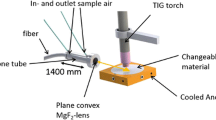Abstract
Ozone is one of the gases produced during argon-shielded arc welding on aluminum alloys. Arc welding superimposes multiple episodes of intense emission of short duration onto the background level during the work shift. Short-duration exposures during welding were measured using colorimetric detector tubes and long-duration exposures, by colorimetric badges utilizing similar chemistry. Both devices were positioned on the lapel in the breathing zone. Many of the short-duration samples exceeded the 8-h TLV–TWA (threshold limit value–time-weighted average) of 0.08 ppm for moderate work during argon-shielded gas metal arc welding (GMAW) also known as metal inert gas (MIG) welding. Some short-duration samples exceeded the transient limit of 0.24 ppm (3× the TLV–TWA), and several exceeded the maximum of 0.40 ppm (5× the TLV–TWA). Exceedance of the maximum in jurisdictions using TLVs as exposure limits necessitates control measures including effective local exhaust ventilation and respiratory protection. Ozone was undetectable (< 0.04 ppm) during gas tungsten arc welding (GTAW) also known as tungsten inert gas (TIG) welding. During long-duration sampling, almost all levels during GMAW were ≤ 0.08 ppm h (≤ 0.01 ppm averaged over 8 h), the limit of detection of the sampling device. As a result, ozone is a critical gaseous contaminant (requiring control measures) during GMAW (MIG welding). Protection of the eyes against irritation in sensitive individuals dominates other considerations.


Similar content being viewed by others
References
3M (Minnesota Mining and Manufacturing) (2009) 2009 Respirator selection guide. 3M, Occupational Health and Environmental Safety Division, St Paul
ACGIH (American Conference of Governmental Industrial Hygienists) (2001) Ozone. In Documentation of the TLVs7 and BEIs7. American Conference of Governmental Industrial Hygienists, Cincinnati, [CD-ROM]
ACGIH (American Conference of Governmental Industrial Hygienists) (2018) TLVs and BEIs for chemical substances and physical agents & biological exposure indices. American Conference of Governmental Industrial Hygienists, Cincinnati
Althouse AD, Turnquist CH, Bowditch WA, Bowditch KE (1988) Modern welding. Goodheart-Willock Company, Inc., South Holland
Bollinger N (2004) NIOSH respirator selection logic (DHHS (NIOSH) Publication No. 2005-100). Department of Health and Human Services (US), Centers for Disease Control and Prevention, National Institute for Occupational Safety and Health, Cincinnati
CSA Group (2011) Certification of companies for fusion welding of aluminum (CAN/CSA W47.2-11). CSA Group, Mississauga
Dräger (2011) Dräger—tubes & CMS—handbook. Dräger Safety, Lubeck
Goller JW, Paik NW (1985) A comparison of iron oxide fume inside and outside of welding helmets. Am Ind Hyg Assoc J 46:89–93
Leidel NA, Busch KA, Lynch JR (1977) Occupational exposure sampling manual (DHEW (NIOSH) Publication No. 77-173). Department of Health, Education, and Welfare (US), Public Health Service, Center for Disease Control, National Institute for Occupational Safety and Health, Cincinnati
McManus TN, Haddad AN (2013) UV and blue light exposures in an aluminum shipbuilding environment. Int J Open Scient Res 1(6):15–27
McManus TN, Haddad AN (2014) Use of methanol as a coolant during machining of aluminum in a shipbuilding environment: a failure to assess and manage risk. Adv Mater Res 955-959:1061–1064. https://doi.org/10.4028/www.scientific.net/AMR.955-959.1061
McManus N, Haddad AN (2015a) Oxygen levels during welding assessment in an aluminum shipbuilding environment. Prof Saf 60(7):26–32
McManus N, Haddad AN (2015b) Argon-related fatigue: an investigation in an aluminum shipbuilding environment. Prof Saf 60(10):47–55
McManus TN, Haddad AN (2016) Chromium emissions during welding in an aluminum shipbuilding environment. Weld J 95(03):86-s–92-s
Morphix Technologies (2017) ChromAir System. Operating instructions for ozone monitor (Part Number 380010). Morphix Technologies, Virginia Beach
NIOSH (National Institute for Occupational Safety and Health) (1988) Criteria for a recommended standard, welding, brazing, and thermal cutting (DHHS (NIOSH) publication no. 88–110). Department of Health and Human Services (US), Public Health Service, Centers for Disease Control, National Institute for Occupational Safety and Health, Cincinnati
NIOSH (National Institute for Occupational Safety and Health) (2007) NIOSH pocket guide to chemical hazards (DHHS (NIOSH) Publication No. 2005-149, August 2006 with minor technical changes, September 2007, with minor technical changes). Department of Health and Human Services (US), Public Health Service, Centers for Disease Control, National Institute for Occupational Safety and Health, Cincinnati
Reid N, Yap D, Bloxam R (2008) The potential role of background ozone on current and emerging air issues: an overview. Air Qual Atmos Health 1:19–29
Seinfeld JH, Pandis SN (1998) Atmospheric chemistry and physics—from air pollution to climate change. Wiley, New York
Thermo Electron (2004) Model 42C, chemiluminescence NO-NO2-NOx analyzer. Thermo Electron Corporation, Franklin
White WH (2009) Considerations in the use of ozone and PM2.5 data for exposure assessment. Air Qual Atmos Health 2:223–230
Funding
This work is financially supported by CAPES (Coordenação de Aperfeiçoamento de Pessoal de Nível Superior), Brasilia, DF, Brasil and CNPq (Conselho Nacional de Desenvolvimento Científico e Tecnológico), formerly Conselho Nacional de Pesquisas, Brasilia, DF, Brasil (the Brazililian National Research Council).
Author information
Authors and Affiliations
Corresponding author
Ethics declarations
Conflict of interest
The authors declare that they have no conflict of interest.
Electronic supplementary material
ESM 1
(DOCX 20 kb)
Rights and permissions
About this article
Cite this article
McManus, T.N., Haddad, A.N. Ozone: a critical contaminant produced during gas metal arc welding (GMAW) on aluminum alloys—resolving the short- versus long-duration sampling discrepancy. Air Qual Atmos Health 12, 97–106 (2019). https://doi.org/10.1007/s11869-018-0634-9
Received:
Accepted:
Published:
Issue Date:
DOI: https://doi.org/10.1007/s11869-018-0634-9




